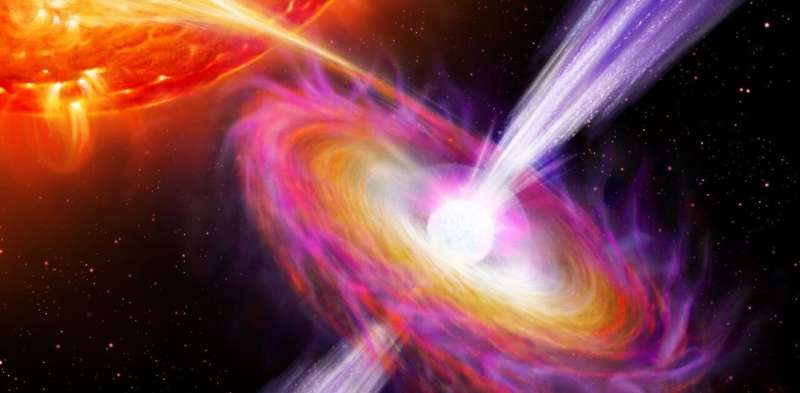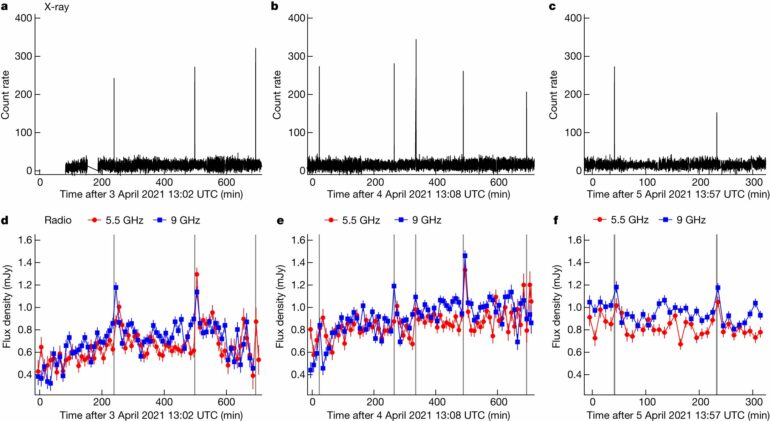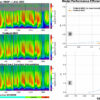How fast can a neutron star drive powerful jets into space? The answer, it turns out, is about one-third the speed of light, as our team has just revealed in a new study published in Nature.
Energetic cosmic beams known as jets are seen throughout our universe. They are launched when material—mainly dust and gas—falls in towards any dense central object, such as a neutron star (an extremely dense remnant of a once-massive star) or a black hole.
The jets carry away some of the gravitational energy released by the infalling gas, recycling it back into the surroundings on far larger scales.
The most powerful jets in the universe come from the biggest black holes at the centers of galaxies. The energy output of these jets can affect the evolution of an entire galaxy, or even a galaxy cluster. This makes jets a critical, yet intriguing, component of our universe.
Although jets are common, we still don’t fully understand how they are launched. Measuring the jets from a neutron star has now given us valuable information.
Jets from stellar corpses
Jets from black holes tend to be bright, and have been well studied. However, the jets from neutron stars are typically much fainter, and much less is known about them.
This presents a problem, since we can learn a lot by comparing the jets launched by different celestial objects. Neutron stars are extremely dense stellar corpses—cosmic cinders the size of a city, yet containing the mass of a star. We can think of them as enormous atomic nuclei, each about 20 kilometers across.
In contrast to black holes, neutron stars have both a solid surface and a magnetic field, and gas falling onto them releases less gravitational energy. All of these properties will have an effect on how their jets are launched, making studies of neutron star jets particularly valuable.
One key clue to how jets are launched comes from their speeds. If we can determine how jet speeds vary with the mass or spin of the neutron star, that would provide a powerful test of theoretical predictions. But it is extremely challenging to measure jet speeds accurately enough for such a test.
A cosmic speed camera
When we measure speeds on Earth, we time an object between two points. This could be a 100-meter sprinter running down the track, or a point-to-point speed camera tracking a car.
Our team, led by Thomas Russell from the Italian National Institute of Astrophysics in Palermo, conducted a new experiment to do this for neutron star jets.
What has made this measurement so difficult in the past is that jets are steady flows. This means there is no single starting point for our timer. But we were able to identify a short-lived signal at X-ray wavelengths that we could use as our “starting gun.”
Being so dense, neutron stars can “steal” matter from a nearby orbiting companion star. While some of that gas is launched outwards as jets, most of it ends up falling onto the neutron star. As the material piles up, it gets hotter and denser.
When enough material has built up, it triggers a thermonuclear explosion. A runaway nuclear fusion reaction occurs and rapidly spreads to engulf the entire star. The fusion lasts for a few seconds to minutes, causing a short-lived burst of X-rays.
One step closer to solving a mystery
We thought this thermonuclear explosion would disrupt the neutron star’s jets. So, we used CSIRO’s Australia Telescope Compact Array to stare at the jets for three days at radio wavelengths to try and catch the disruption. At the same time, we used the European Space Agency’s Integral telescope to look at the X-rays from the system.
To our surprise, we found the jets got brighter after every pulse of X-rays. Instead of disrupting the jets, the thermonuclear explosions seemed to power them up. And this pattern was repeated ten times in one neutron star system, and then again in a second system.

Nuclear explosions on a neutron star feed its jets. © Danielle Futselaar and Nathalie Degenaar, Anton Pannekoek Institute, University of Amsterdam, CC BY-SA
We can explain this surprising result if the X-ray pulse causes gas swirling around the neutron star to fall inwards more quickly. This, in turn, provides more energy and material to divert into the jets.
Most importantly, however, we can use the X-ray burst to indicate the launch time of the jets. We timed how long they took to move outwards to where they became visible at two different radio wavelengths. These start and finish points provided us with our cosmic speed camera.
Interestingly, the jet speed we measured was close to the “escape speed” from a neutron star. On Earth, this escape speed is 11.2 kilometers per second—what rockets need to achieve to break free of Earth’s gravity. For a neutron star, that value is around half the speed of light.
Our work has introduced a new technique for measuring neutron star jet speeds. Our next steps will be to see how the jet speed changes for neutron stars with different masses and rotation rates. That will allow us to directly test theoretical models, taking us one step closer to figuring out how such powerful cosmic jets are launched.
More information:
Thomas D. Russell et al, Thermonuclear explosions on neutron stars reveal the speed of their jets, Nature (2024). DOI: 10.1038/s41586-024-07133-5
This article is republished from The Conversation under a Creative Commons license. Read the original article.
Citation:
A cosmic ‘speed camera’ just revealed the staggering speed of neutron star jets in a world first (2024, March 30)



